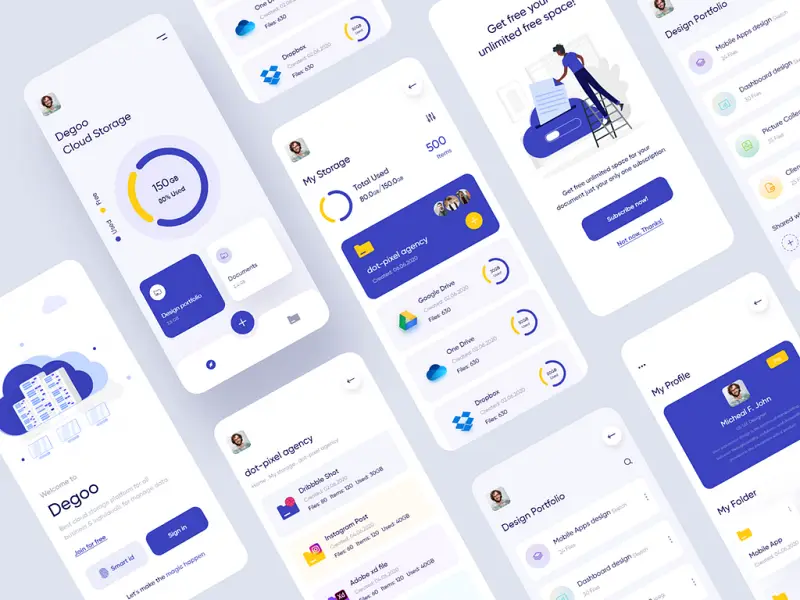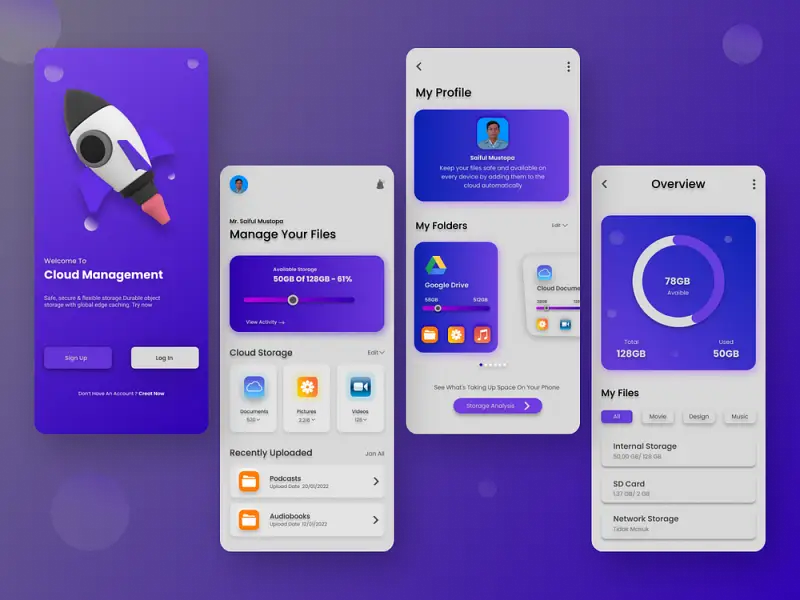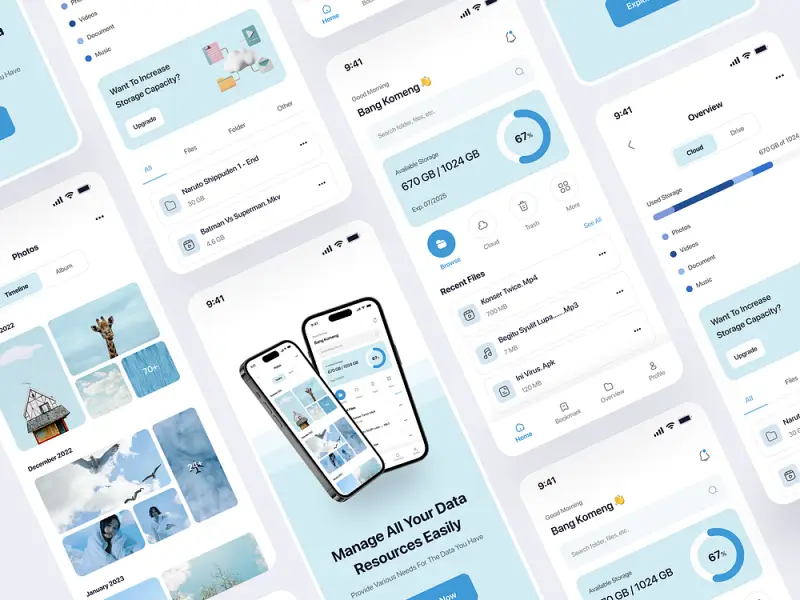

Industry reports show that storage and performance issues affect over 70% of digital workspaces as business mobile apps grow. Cloud computing effectively addresses these challenges.
Cloud-based app development simplifies data collection, security, and management. It helps businesses create apps that enhance customer experience and revenue. It also supports low-code development, saving time and money.
In this article, we’ll explore cloud-based application solutions, their benefits, and how to develop a cloud app the right way.
A cloud-based application operates over the internet, storing and processing data online, with its operations managed in the cloud. Users interact with these applications through a web or mobile browser. The data processing occurs on a remote server via an API, with the user’s device acting merely as an input mechanism and not involved in the main operations.
It’s important to note that cloud-based applications differ from web-based applications. To understand the unique aspects of cloud app development, we need to look at the specific characteristics that define it.

SaaS allows the creation of cloud applications accessible via web browsers and mobile apps. Customers can use these applications through the internet without installing or configuring local devices. Developing SaaS cloud applications can be used for:
Tech giants like AWS, Salesforce, Google Apps, and Zendesk have invested in SaaS cloud app development.
More insights about Cloud Development for you:PaaS lets you rent all the resources and services needed to develop an application, relying on cloud providers for infrastructure, operating systems, and development tools. This means you use a complete cloud application platform, both software and hardware, as a service for development.
PaaS cloud application development can be used for:
Common PaaS cloud platforms include OpenShift, Windows Azure, and Heroku.
In IaaS, your cloud provider manages your entire business infrastructure, including network, servers, storage, and virtualization. This can be done through a private or public cloud. IaaS cloud services also offer many additional tools for cloud-based app development, such as:
To use IaaS cloud services, you can use an admin panel or API for better control. You can manage your programs and operating systems while your provider handles the infrastructure.
Popular examples of cloud applications using IaaS include Zoom, PayPal, and Slack.
Looking to Build a Cloud Native App?
Contact TECHVIFY – Vietnam’s Leading Offshore Software Development & Outsourcing Company, for consultation and development services.
Contact UsDevelopers need to consider certain prerequisites before building applications in the cloud. These prerequisites provide the essential knowledge and skills needed for success. Understanding these basics is crucial for creating robust and scalable cloud solutions.
Programming Languages: Proficiency in key programming languages is essential. Common languages include Python, Java, and C#. Each language has its strengths and is suited for different types of applications. For example, Python is favored for its simplicity and quick development, while Java is known for its reliability in large-scale enterprise applications.
Cloud Concepts: It’s important to understand the basics of cloud computing. Get familiar with concepts like Infrastructure-as-a-Service (IaaS) and Software-as-a-Service (SaaS). Knowing about different cloud deployment models, such as public and hybrid clouds, is also useful.
Application Architecture: Understanding application architecture principles is key to designing scalable and maintainable cloud applications. Learn about microservices, serverless architecture, and containerization, as these are important for modern cloud app development.

Cloud App Development Requirements
Web Development: Cloud applications are mainly accessed through web browsers and mobile devices. A thorough grasp of web development technologies, including JavaScript and its frameworks, is necessary to create engaging and responsive user interfaces.
Database Management: Cloud applications rely heavily on databases to store and manage data. It is crucial to understand different database types, such as relational and NoSQL databases, and how to interact with them using queries and APIs.
Security Best Practices: Security is crucial for cloud applications. Knowledge of best practices, such as encryption, authentication, and authorization, is essential to protect data and defend against cyber threats.
Networking Concepts: Cloud applications interact with services and components over the internet. Understanding concepts like DNS and load balancing helps optimize application performance.
Before developing a cloud-based application, it’s essential to identify your target market, understand their problems, and assess the demand for your app. Next, evaluate how your product can address these issues. Following this analysis, you can proceed with the steps below to design a cloud-based application effectively:
Hiring dedicated developers for cloud development can significantly increase your chances of creating successful software. A trusted cloud app development company can offer a detailed project planning report, an estimate of app development costs, and an analysis of your business model.
Your cloud application developers will support you in several critical areas before the actual development process begins:
For an effective cloud-based app development process, consider aspects like service models, app architecture, and cloud migration. These choices directly impact your app’s performance, so it’s crucial to discuss what works best with your development team.

Cloud Application Development Process
Once all essential functionalities and elements are defined, the process moves on to the UI/UX design phase. The goal is to create an attractive, user-friendly interface to encourage user interaction. Clients can review, comment on, and provide feedback on the design as it progresses. Finally, designers will provide an overall project completion estimate.
Agile and Scrum development methodologies are commonly used in creating cloud applications. The development process is typically divided into sprints, each lasting about ten working days. Developing cloud-native applications is important because they offer greater customization and simpler procedures.
Before release, the product undergoes various quality assurance tests to ensure it delivers the desired user experience. Full-cycle development outsourcing firms offer comprehensive services, including design, development, testing, and management, which contribute to higher-quality products.
You can publish your cloud app on the App Store (iOS) or Google Play (Android). Google Play uses automated testing to speed up the approval process. However, if your app is denied, Google does not provide specific reasons. Google Play also does not have an equivalent fee like the App Store.
The App Store uses human reviewers to validate apps. If they reject your app, they will ask for specific improvements before approval. Keep in mind that releasing an app may require additional development, modifications, and time. Understanding the typical costs involved in developing a cloud application is important.
Learn More On:The cost of building a cloud application can vary widely based on several factors, including the application’s complexity, the technology stack, the development team’s location and expertise, and ongoing maintenance needs. Below are some key elements to consider when estimating the cost:
| Region | Average Hourly Rate | Simple Application | Moderate Application | Complex Application |
|---|---|---|---|---|
| North America | $100 – $200 | $10,000 – $40,000 | $40,000 – $200,000 | $200,000 – $1,000,000 |
| Western Europe | $80 – $150 | $8,000 – $30,000 | $30,000 – $150,000 | $150,000 – $750,000 |
| Eastern Europe | $30 – $75 | $3,000 – $15,000 | $15,000 – $75,000 | $75,000 – $375,000 |
| Asia | $20 – $50 | $2,000 – $10,000 | $10,000 – $50,000 | $50,000 – $250,000 |
| South America | $25 – $60 | $2,500 – $12,000 | $12,000 – $60,000 | $60,000 – $300,000 |
| Africa | $20 – $40 | $2,000 – $8,000 | $8,000 – $40,000 | $40,000 – $200,000 |
Asia is an attractive option for those looking for a balance of cost and quality. The region offers:
When looking for a development partner in Asia, consider:
Cloud computing is transforming business operations by resolving storage and performance challenges that over 70% of digital workspaces face. It simplifies data management, enhances security, and supports low-code development, ultimately boosting customer experience and revenue.
Asia offers an optimal balance of cost and quality for cloud app development, with competitive pricing and a pool of highly skilled developers.
Ready to elevate your business with a top-tier cloud application? Contact TECHVIFY today and leverage our expertise to build robust, scalable, and high-quality cloud solutions. Let’s transform your vision into reality—reach out now and get started!
TECHVIFY – Global AI & Software Solutions Company
For MVPs and Market Leaders: TECHVIFY prioritizes results, not just deliverables. Reduce time to market & see ROI early with high-performing Teams & Software Solutions.